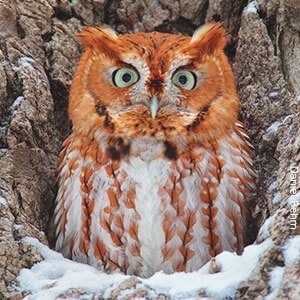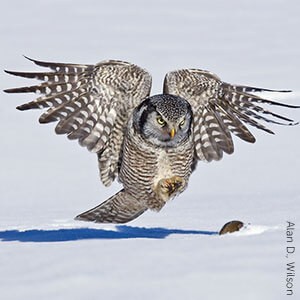Are Screech Owl And Hawk Owl Comparable In Size? This is a common question among bird enthusiasts, and understanding the size differences between these two fascinating owl species can enhance appreciation for their unique adaptations. At COMPARE.EDU.VN, we provide comprehensive comparisons to help you understand the nuances between various species. This article delves into a detailed comparison of their sizes, habitats, and other characteristics, offering a clear understanding of each owl. Learn more about these avian predators, their physical attributes, and ecological roles.
1. Introduction: Screech Owl and Hawk Owl
Screech owls (Genus Megascops) and Hawk owls (Surnia ulula) are two distinct types of owls that inhabit different regions and ecological niches. Screech owls are typically smaller, more compact owls found in wooded areas, while hawk owls are medium-sized owls with a hawk-like appearance, inhabiting boreal forests. Understanding their size, appearance, and habitat preferences is key to differentiating between these birds of prey. This in-depth guide, brought to you by COMPARE.EDU.VN, explores their similarities and differences.
2. Understanding Screech Owls
2.1. General Characteristics
Screech owls are small, stocky owls belonging to the genus Megascops. They are known for their distinctive “screeching” calls, though the sounds are more of a tremolo or whistle than a screech. These owls are highly adaptable and can be found in a variety of habitats, from forests to suburban areas.
2.2. Species and Distribution
There are several species of screech owls, with the Eastern Screech Owl (Megascops asio) and Western Screech Owl (Megascops kennicottii) being the most common in North America. Eastern Screech Owls are found throughout the eastern United States and southeastern Canada, while Western Screech Owls inhabit the western United States and southwestern Canada.
2.3. Physical Attributes
Screech owls are relatively small, typically measuring between 7 to 10 inches in height. They have a round head with prominent ear tufts (also known as “horns”), which are feathers that resemble ears but are not actually ears. Their plumage varies in color, with some individuals being reddish-brown (rufous) and others being gray.
2.4. Habitat and Behavior
Screech owls are nocturnal birds, meaning they are most active at night. They prefer wooded areas, parks, and suburban gardens with trees. These owls are opportunistic hunters, feeding on a variety of prey, including insects, small mammals, and birds. They often nest in tree cavities, nest boxes, or other natural openings.
3. Understanding Hawk Owls
3.1. General Characteristics
Hawk owls, scientifically known as Surnia ulula, are medium-sized owls that bear a striking resemblance to hawks. They are named for their long tails, pointed wings, and diurnal (daytime) hunting habits, which are more characteristic of hawks than typical owls.
3.2. Species and Distribution
The Northern Hawk Owl is the only species in the Surnia genus. These owls are found in the boreal forests of North America, Europe, and Asia. In North America, they primarily inhabit Canada and Alaska, with occasional irruptions into the northern United States during winter.
3.3. Physical Attributes
Hawk owls are larger than screech owls, typically measuring between 15 to 17 inches in height. They have a distinctive appearance, with a round head, bright yellow eyes, and a long tail that accounts for nearly half of their total length. Their plumage is predominantly dark brown on the upperparts and white with brown barring on the underparts.
3.4. Habitat and Behavior
Hawk owls are diurnal hunters, often seen perched atop trees or poles, scanning for prey. They prefer open boreal forests and taiga habitats with scattered trees and clearings. Their diet consists mainly of small mammals, particularly voles, but they will also hunt birds and insects when available. They nest in tree cavities or on top of broken tree stumps.
4. Size Comparison: Screech Owl vs. Hawk Owl
4.1. Height and Length
One of the most notable differences between screech owls and hawk owls is their size. Screech owls typically range from 7 to 10 inches in height, while hawk owls measure between 15 to 17 inches. This means that hawk owls are significantly larger than screech owls, often nearly twice the size.
4.2. Weight
Screech owls typically weigh between 4 to 8 ounces, while hawk owls weigh between 8 to 16 ounces. The hawk owl’s greater weight reflects its larger size and more robust build.
4.3. Wingspan
The wingspan of screech owls ranges from 18 to 24 inches, while hawk owls have a wingspan of 28 to 35 inches. The larger wingspan of the hawk owl allows it to cover more ground while hunting and provides greater stability in flight.
4.4. Detailed Comparison Table
To illustrate the size differences more clearly, here is a comparison table:
| Feature | Screech Owl (Eastern) | Hawk Owl |
|---|---|---|
| Height/Length | 7-10 inches | 15-17 inches |
| Weight | 4-8 ounces | 8-16 ounces |
| Wingspan | 18-24 inches | 28-35 inches |
| General Appearance | Small, stocky | Medium, hawk-like |


5. Habitat and Geographical Distribution
5.1. Screech Owl Habitats
Screech owls are highly adaptable and can thrive in various habitats, including deciduous forests, urban parks, and suburban areas. They are commonly found in the eastern and western regions of North America, with the Eastern Screech Owl inhabiting the eastern United States and the Western Screech Owl found in the western United States.
5.2. Hawk Owl Habitats
Hawk owls prefer boreal forests and taiga regions, which are characterized by coniferous trees and open clearings. These owls are typically found in Canada, Alaska, and parts of northern Europe and Asia. They require open areas for hunting and dense forests for nesting and roosting.
5.3. Overlapping Regions
While their primary habitats differ, there can be some overlap in regions where both screech owls and hawk owls are found, particularly during winter irruptions. However, their distinct habitat preferences and hunting behaviors generally keep them from competing directly for resources.
6. Hunting and Diet
6.1. Screech Owl Hunting Strategies
Screech owls are nocturnal hunters that use their keen hearing and sharp talons to capture prey. They often perch on branches or poles, waiting to ambush small mammals, insects, and birds. Their diet is highly varied and depends on the availability of prey in their habitat.
6.2. Hawk Owl Hunting Strategies
Hawk owls are diurnal hunters, meaning they are active during the day. They have excellent eyesight and can spot prey from great distances. They often hover or glide over open areas, searching for voles and other small mammals. Their hawk-like hunting style allows them to be efficient predators in their boreal forest habitat.
6.3. Diet Composition
The diet of screech owls includes insects, small mammals (such as mice and voles), birds, amphibians, and reptiles. Hawk owls primarily feed on small mammals, especially voles, but they will also hunt birds and insects when available. The dietary differences reflect the availability of prey in their respective habitats.
7. Vocalizations and Calls
7.1. Screech Owl Calls
Screech owls are known for their distinctive calls, which are not actually screeches but rather a series of soft trills and whistles. The Eastern Screech Owl produces a mournful, descending whinny, while the Western Screech Owl emits a series of short hoots. These calls are used for communication, territorial defense, and attracting mates.
7.2. Hawk Owl Calls
Hawk owls have a variety of calls, including a high-pitched trill, a series of whistles, and a harsh screech. Their calls are less commonly heard than those of screech owls, as they are less vocal and inhabit more remote areas. The calls are used for communication and territorial displays.
7.3. Comparison of Vocalizations
While both owls use vocalizations for communication, their calls differ significantly. Screech owl calls are softer and more melodic, while hawk owl calls are higher-pitched and more piercing. These differences in vocalizations reflect their different ecological roles and communication needs.
8. Conservation Status and Threats
8.1. Screech Owl Conservation
Screech owls are generally common and widespread, but they face several threats, including habitat loss, pesticide poisoning, and vehicle collisions. Conservation efforts focus on protecting and restoring their habitat, reducing pesticide use, and mitigating the risk of vehicle collisions.
8.2. Hawk Owl Conservation
Hawk owls are relatively stable in population, but they are vulnerable to habitat loss from logging and development. Climate change may also impact their boreal forest habitat. Conservation efforts focus on preserving large tracts of boreal forest and monitoring their populations.
8.3. Conservation Efforts
Organizations like the American Bird Conservancy are working to protect owls by improving key habitats, banning dangerous pesticides, and pushing for improved protections. Supporting these efforts can help ensure the survival of both screech owls and hawk owls.
9. Distinguishing Features Beyond Size
9.1. Plumage and Appearance
While size is a key difference, plumage and appearance also help distinguish between screech owls and hawk owls. Screech owls have a stocky build with prominent ear tufts and variable plumage colors (reddish-brown or gray). Hawk owls have a slender, hawk-like build with a long tail and predominantly dark brown and white plumage.
9.2. Behavioral Differences
Screech owls are nocturnal ambush predators, while hawk owls are diurnal hunters that actively search for prey. These behavioral differences reflect their adaptations to different habitats and ecological niches.
9.3. Habitat Preferences
Screech owls are adaptable and can be found in various habitats, while hawk owls are specialized for boreal forests. Their habitat preferences further differentiate these two owl species.
10. Ecological Roles
10.1. Screech Owl’s Role in Ecosystems
Screech owls play an important role in controlling populations of insects, rodents, and other small animals. They help maintain the balance of ecosystems in their habitats and contribute to overall biodiversity.
10.2. Hawk Owl’s Role in Ecosystems
Hawk owls are key predators in boreal forests, helping to regulate vole populations and other small mammals. They also serve as an indicator species, reflecting the health and stability of their forest habitat.
10.3. Importance of Predators
Both screech owls and hawk owls are important predators that contribute to the health and stability of their respective ecosystems. Protecting these owls and their habitats is essential for maintaining biodiversity and ecological balance.
11. Cultural Significance
11.1. Owls in Mythology
Owls have long held cultural significance in various societies, often associated with wisdom, mystery, and magic. In some cultures, owls are seen as symbols of death or bad luck, while in others, they are revered as protectors and guides.
11.2. Owls in Literature and Art
Owls have been featured in literature, art, and folklore for centuries, often depicted as wise and enigmatic creatures. Their unique appearance and nocturnal habits have made them popular subjects for artists and writers.
11.3. Owls in Modern Culture
In modern culture, owls continue to be popular symbols, often used in advertising, entertainment, and conservation campaigns. Their image is used to promote environmental awareness and the importance of protecting wildlife and their habitats.
12. Tips for Identifying Owls in the Wild
12.1. Visual Identification
When identifying owls in the wild, consider their size, shape, plumage, and facial features. Use field guides and online resources to compare your observations with known characteristics of different owl species.
12.2. Auditory Identification
Listen for distinctive owl calls and learn to identify them by ear. Screech owls, for example, have unique trills and whistles that are easily recognizable.
12.3. Habitat and Location
Pay attention to the habitat and geographical location where you spot the owl. This can help narrow down the list of possible species, as some owls are more common in certain regions and habitats.
13. Frequently Asked Questions (FAQ)
13.1. Are Screech Owls and Hawk Owls Related?
No, screech owls (genus Megascops) and hawk owls (Surnia ulula) are not closely related. They belong to different genera within the owl family Strigidae.
13.2. What Is the Size Difference Between Screech Owls and Hawk Owls?
Hawk owls are significantly larger than screech owls. Screech owls typically measure 7-10 inches in height, while hawk owls measure 15-17 inches.
13.3. Where Do Screech Owls and Hawk Owls Live?
Screech owls are found in various habitats across North America, while hawk owls primarily inhabit boreal forests in Canada and Alaska.
13.4. What Do Screech Owls and Hawk Owls Eat?
Screech owls have a varied diet that includes insects, small mammals, and birds. Hawk owls primarily feed on small mammals, especially voles.
13.5. Are Screech Owls and Hawk Owls Active During the Day or Night?
Screech owls are nocturnal, while hawk owls are diurnal.
13.6. How Can I Attract Screech Owls to My Yard?
You can attract screech owls to your yard by providing suitable habitat, such as trees and nest boxes.
13.7. What Should I Do If I Find an Injured Owl?
If you find an injured owl, contact a local wildlife rehabilitator or animal rescue organization for assistance.
13.8. How Can I Help Protect Owls?
You can help protect owls by supporting conservation organizations, reducing pesticide use, and protecting their habitat.
13.9. What Are the Main Threats to Owl Populations?
The main threats to owl populations include habitat loss, pesticide poisoning, and vehicle collisions.
13.10. Are Owls Protected by Law?
Yes, most owl species are protected by law under the Migratory Bird Treaty Act.
14. Conclusion: Making Informed Comparisons
Understanding the differences between screech owls and hawk owls involves considering their size, habitat, hunting behavior, and vocalizations. While screech owls are small, adaptable nocturnal hunters, hawk owls are larger, diurnal predators of boreal forests. By comparing these characteristics, it becomes clear that while they are both owls, they occupy different ecological niches and have unique adaptations.
At COMPARE.EDU.VN, we strive to provide comprehensive and reliable comparisons to help you make informed decisions and gain a deeper understanding of the world around you. Whether you’re comparing different species of owls or evaluating various products and services, our goal is to provide you with the information you need to make the best choice.
15. Call to Action
Ready to explore more comparisons and make informed decisions? Visit COMPARE.EDU.VN today to discover detailed comparisons of a wide range of topics. Whether you’re interested in wildlife, technology, or everyday products, we have the information you need to make the right choice. Don’t make decisions in the dark – let COMPARE.EDU.VN illuminate your path!
For more information or assistance, contact us at:
Address: 333 Comparison Plaza, Choice City, CA 90210, United States
Whatsapp: +1 (626) 555-9090
Website: compare.edu.vn
